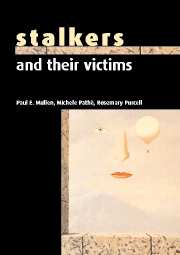Book contents
- Frontmatter
- Contents
- Acknowledgements
- Introduction
- 1 Stalking – a new categorization of human behaviour
- 2 The epidemiology of stalking
- 3 The victims of stalkers
- 4 Classifying stalkers
- 5 The rejected stalker and the resentful stalker
- 6 The predatory stalker
- 7 Intimacy seekers and incompetent suitors
- 8 The erotomanias and the morbid infatuations
- 9 Same gender stalking
- 10 Stalking by proxy
- 11 False victims of stalking
- 12 Stalking and assault
- 13 Reducing the impact of stalking
- 14 Defining and prosecuting the offence of stalking
- 15 Assessing and managing the stalker
- Appendix A Victim services
- Appendix B Important anti-stalking Acts/statutes
- Legal cases and references
- Index
8 - The erotomanias and the morbid infatuations
Published online by Cambridge University Press: 05 March 2012
- Frontmatter
- Contents
- Acknowledgements
- Introduction
- 1 Stalking – a new categorization of human behaviour
- 2 The epidemiology of stalking
- 3 The victims of stalkers
- 4 Classifying stalkers
- 5 The rejected stalker and the resentful stalker
- 6 The predatory stalker
- 7 Intimacy seekers and incompetent suitors
- 8 The erotomanias and the morbid infatuations
- 9 Same gender stalking
- 10 Stalking by proxy
- 11 False victims of stalking
- 12 Stalking and assault
- 13 Reducing the impact of stalking
- 14 Defining and prosecuting the offence of stalking
- 15 Assessing and managing the stalker
- Appendix A Victim services
- Appendix B Important anti-stalking Acts/statutes
- Legal cases and references
- Index
Summary
Introduction
The emergence of stalking as a distinct category of behaviour brought the topic of erotomania into the clinical limelight. The new found prominence of a syndrome that has previously languished among the uncommon, not to say obscure, psychiatric syndromes, highlighted the inadequacy as well as the utilities of what had been a venerable, if little used, conceptualization. A detailed account of erotomania and its variants is now provided, in part because such disorders are the origin of many intimacy seeker's behaviour and in part because it still provides the richest source of clinical literature relating to stalking.
Currently the erotomanias tend to be viewed as conditions characterized by a delusional system that centres on the belief that the sufferer is the object of the love of another. The erotomanias are considered to exist either as primary (pure) or secondary (symptomatic) conditions. The primary erotomanias are a monodelusional state unaccompanied by other severe disturbances of mental state such as hallucinations. The secondary erotomanias involve a delusional system arising in the context of a pre-existing psychotic condition, for example schizophrenia. To a greater or lesser extent each of the elements that constitute this conceptualization are under challenge. The exclusive emphasis on a delusional belief in being loved, which excludes pathological infatuation, has been questioned (Stone, 1984; Mullen & Pathé, 1994a).
- Type
- Chapter
- Information
- Stalkers and their Victims , pp. 129 - 156Publisher: Cambridge University PressPrint publication year: 2000



